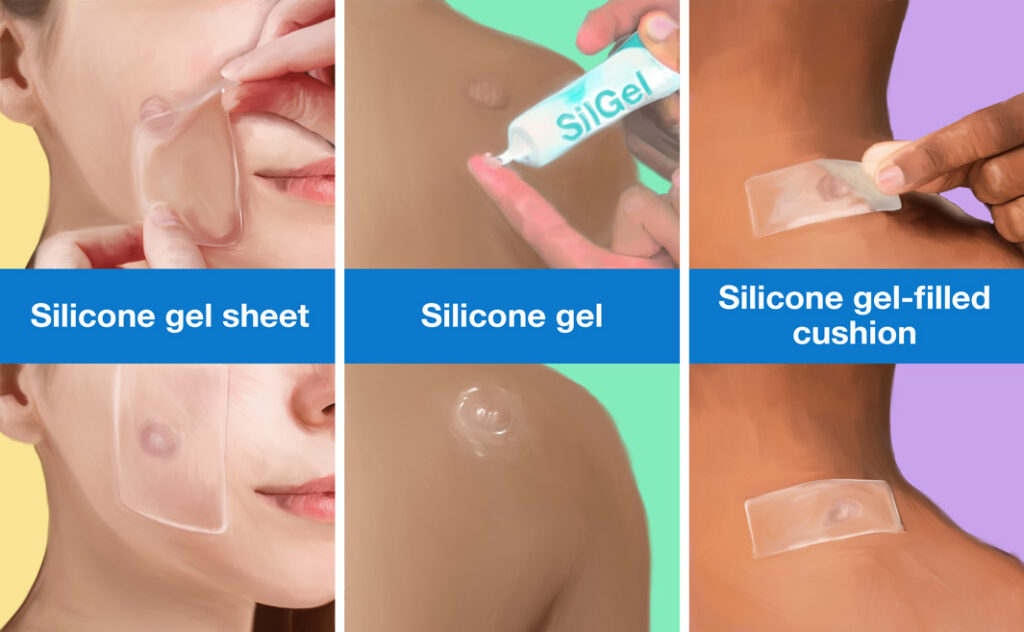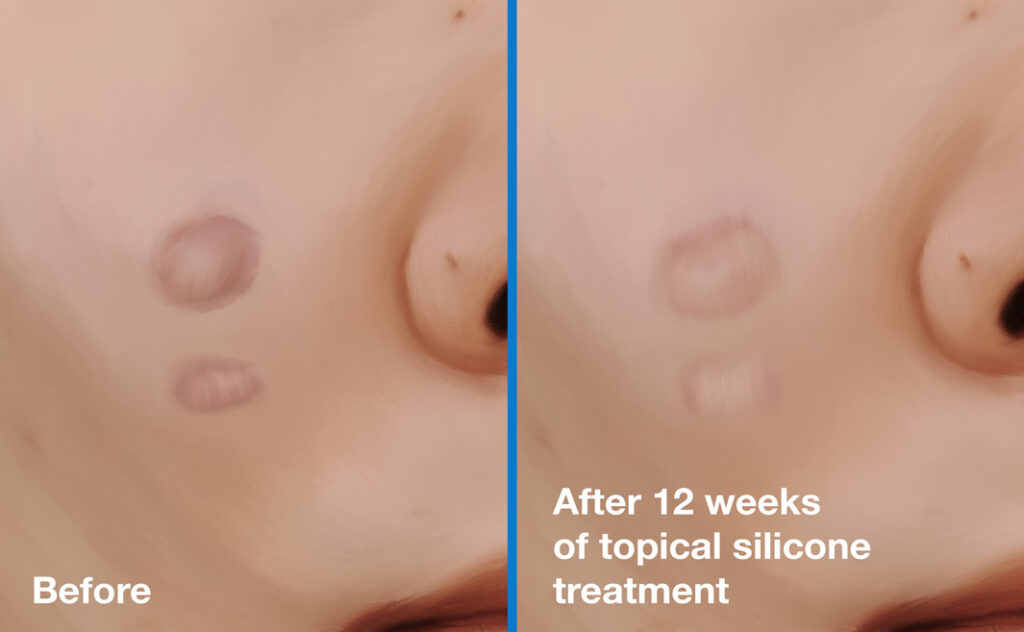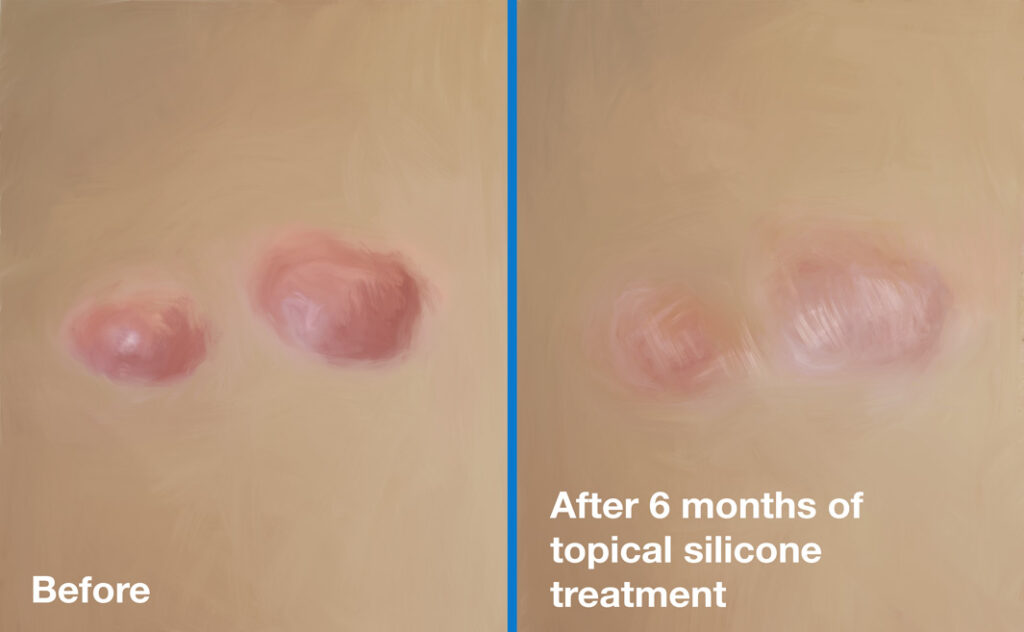Topical silicone treatment is the application of a gel or gel sheet containing silicone to the hypertrophic or keloid scar. Hypertrophic and keloid scars result when the skin produces too much collagen as it repairs itself. Topical silicone treatment seems to reduce the size of these raised scars by decreasing the production of collagen in the skin. However, exactly how silicone treatment achieves this is not known.
Because it is so safe and inexpensive, doctors who specialize in treating hypertrophic and keloid scars recommend silicone gel sheeting as a first line of treatment for these raised scars, despite its sometimes unimpressive results.1,2
As with all scar repair treatments, topical silicone treatment is sometimes combined with other scar repair procedures to achieve desired results.
People with active acne should not undergo acne scar revision of any kind, including topical silicone treatment. Be sure that your skin is clear of acne before beginning scar revision.
Before agreeing to undergo topical silicone treatment, talk to multiple doctors about your options, expected outcomes, and treatment prices.
Procedure details:
In topical silicone treatment, silicone is applied to the scar in one of the following forms:
- A silicone gel sheet: A silicone gel sheet is cut to fit the size of the scar and applied daily for at least 10 hours a day for about 2 months. After 2 months, the doctor will examine the scar for any improvement and decide whether to continue or stop the treatment. If the treatment proves effective, it may continue for up to 6 months. If mild side effects occur, the doctor may recommend temporarily stopping the treatment or wearing the sheet for shorter periods of time until the side effects clear up.1-6
- A silicone gel: A thin coat of silicone gel is applied to the skin twice a day for about 6 months. If the treatment causes mild side effects, the doctor may recommend temporarily stopping the treatment until the side effects disappear.6,7
- A silicone gel-filled cushion: A cushion filled with silicone gel is usually worn for at least 10 hours a day for about 4 months. If mild side effects occur, the doctor may recommend temporarily stopping the treatment or wearing the cushion for shorter periods of time until the side effects clear up.4

Scientists do not yet know exactly how topical silicone treatment reduces the size of hypertrophic and keloid scars. The silicone itself does not actually seem to penetrate into the skin.8 Instead, some other possibilities are that:
- Maybe topical silicone treatments work by trapping moisture in the skin. There are different ways in which keeping the skin hydrated might help to reduce scar size:
- Fibroblasts (cells that make collagen) might be less active in moist skin and might produce less collagen. Less collagen would result in a smaller scar.
- Moist skin might need fewer blood vessels than dry skin. Since blood is what brings collagen to the scar site, fewer blood vessels might mean less collagen and ultimately a smaller scar.
- Perhaps silicone gel sheets work by applying pressure to raised scars. However, this explanation does not account for topical silicone gel, which is not heavy enough to create pressure but still seems to reduce the size of raised scars.1,8
It should be noted that these explanations are highly speculative. We just don’t know yet why topical silicone treatment works to reduce the size of raised scars.
Anesthesia:
Topical silicone treatment is painless, so no numbing or anesthesia is necessary before the treatment.9
Before-and-after:

A hypertrophic scar before (left) and after (right) 12 weeks of topical silicone treatment.

A hypertrophic scar before (left) and after (right) 6 months of topical silicone treatment. The scar was treated with a silicone gel.
References
- Levy LL, and Zeichner JA. Management of acne scarring, part II. A comparative review of non-laser-based, minimally invasive approaches. Am J Clin Dermatol. 13(5), 331-340 (2012).
- Basson R, Bayat A. Skin scarring: Latest update on objective assessment and optimal management. Front Med (Lausanne). 9(1), 942756 (2022).
- Wigger-Albert W, et al. Efficacy of a polyurethane dressing versus a soft silicone sheet on hypertrophic scars. J Wound Care. 18(5), 208, 210-4 (2009).
- Berman B, and Flores F. Comparison of a silicone gel-filled cushion and silicon gel sheeting for the treatment ofhypertrophic or keloid scars. Dermatol Surg. 25(6), 484-6 (1999).
- Karagoz H, Yuksel F, Ulkur E, and Evinc R. Comparison of efficacy of silicone gel, silicone gel sheeting, and topical onion extract including heparin and allantoin for the treatment of postburn hypertrophic scars. Burns. 35(8), 1097-103 (2009).
- Mikolaszek B, Jamrógiewicz M, Mojsiewicz-Pieńkowska K, Żebrowska M, Sznitowska M, Strankowska J. Physical and Mechanical Evaluation of Silicone-Based Double-Layer Adhesive Patch Intended for Keloids and Scar Treatment Therapy. Polymers (Basel). 8(11), 398 (2016).
- Lacarrubba F, Patania L, Perrotta R, Stracuzzi G, Nasca MR, and Micali G. An open-label pilot study to evaluate the efficacy and tolerability of a silicone gel in the treatmentof hypertrophic scars using clinical and ultrasound assessments. J Dermatolog Treat. 19(1),50-3 (2008).
- Stavrou D, et al. Silicone-based scar therapy: a review of the literature. Aesthetic Plast Surg. 34(5), 646-51 (2010).
- Onselen JV. Scars: impact and management, with a focus on topical silicone-based treatments. Br J Nurs. 27(12), S36-S40 (2018).
 Acne.org Products
Acne.org Products